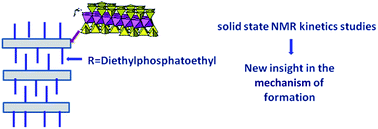Hydrolysis-condensation reactions of diethylphosphato-ethyltriethoxysilane involved in organic–inorganic talc-like hybrid synthesis: liquid and solid-state NMR investigations
Abstract
Hydrolysis and condensation reactions involved in the synthesis of organic–inorganic talc like hybrids (TLH) starting from diethylphosphatoethyltriethoxysilane (SiP), magnesium nitrate (Mg(NO3)2), ethanol and sodium hydroxide have been studied. The influence of magnesium nitrate, concentration of NaOH aqueous solution and pH value of the reaction media was investigated by high resolution 1H, 29Si and 31P liquid Nuclear Magnetic Resonance (NMR) and 29Si and 31P solid state NMR. It was shown that Mg(NO3)2 has a catalytic effect on the hydrolysis-condensation reaction rates of SiP and that high concentrations of NaOH lead to a scission of siloxane bonds as well as a partial hydrolysis of ethoxy groups linked to phosphorous. The final TLH products have been characterized by solid state 29Si NMR.


 Please wait while we load your content...
Please wait while we load your content...